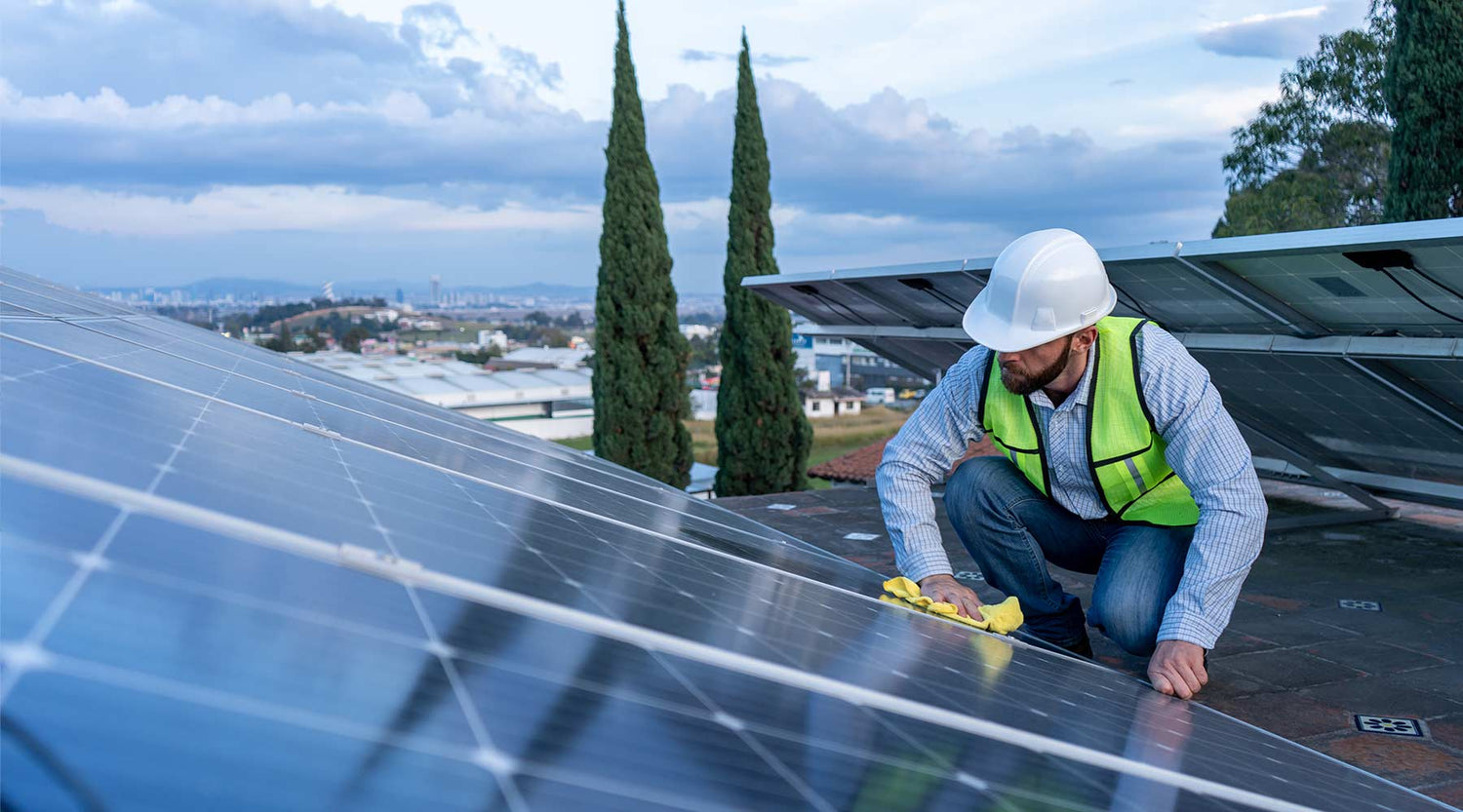A Complete Solar Panel Maintenance Guide for Maximum Efficiency
Regular solar panel maintenance allows panels to operate at their peak, translating every bit of sunlight into power. Maximizing your solar panel efficiency not only supports sustainable energy but also ensures a greater return on your investment. Our guide outlines the essential steps, practical tools, and seasonal care tips to help you keep your panels functioning optimally, even during winter.
Key Tips for Spotting Issues Early
Regular inspections are essential in maintaining solar panel efficiency, helping you catch potential issues before they escalate. During each inspection, be sure to keep an eye on:
- Surface Cleanliness: Check for dirt, debris, or bird droppings that block sunlight and reduce energy output.
- Signs of Wear and Tear: Look for small cracks or scratches, and ensure all mounting components are secure and correctly angled.
- Hardware Check: In windy or rainy regions, verify that mounting hardware remains firmly in place.
Aim to inspect panels every one to two months, adjusting for environmental factors like nearby trees, urban dust, or seasonal storms. Early detection keeps maintenance manageable and extends the life of your panels.
Essential Tools for Cleaning Solar Panels
Cleaning solar panels effectively starts with using the right solar panel cleaning tools. A soft-bristle brush or sponge works well for clearing away surface grime without scratching. For a thorough clean, use deionized or distilled water, which prevents mineral deposits from forming.
An extended-handle squeegee is perfect for reaching high panels and ensuring a streak-free finish, while an eco-friendly cleaning solution helps remove stubborn dirt without damaging your panels. For long-term maintenance, consider a solar panel hydrophobic coating that minimizes dust and debris buildup, simplifying future cleanings.
For some, DIY solar power cleaning supplies and solar panel washing equipment suffice; however, those with larger or harder-to-reach installations may benefit from professional-grade equipment.
Best Practices for Cleaning Solar Panels
Following safe cleaning practices is essential for maintaining solar panel efficiency and preventing accidental damage. Here are the best ways to clean solar panels:
Clean During Cooler Times
Aim to clean panels in the early morning or late evening when the surface is cooler. This minimizes the risk of streaks that can form when water evaporates too quickly in hot conditions, and it provides safer working conditions.
Avoid High-Pressure Water
High-pressure water can damage the delicate surface of solar panels or even impact electrical components within the array. Instead, use a gentle spray or a soft, damp cloth to clean without risking any potential harm.
Use Deionized or Distilled Water
Hard water contains minerals that can leave behind residue or cloud the panel surface over time. Using deionized or distilled water prevents mineral buildup, which helps maintain the clarity and efficiency of your panels.
Select Gentle Cleaning Solutions
When choosing a cleaner, opt for eco-friendly solutions specifically formulated for solar panels, as they’re designed to remove grime without damaging sensitive surfaces. Avoid abrasive or harsh chemicals, which can scratch or corrode the panel coating.
Adjust Cleaning Frequency Based on Local Conditions
The optimal cleaning frequency depends on your environment. Dustier areas, storm-prone regions, or locations with overhanging trees may require more frequent cleaning. Seasonal weather patterns, such as dry summers or stormy autumns, can also impact how often panels need attention.
Seasonal Care Tips to Maximize Solar Panel Output
Solar panel performance can vary significantly with seasonal changes, so adjusting your maintenance routine throughout the year is essential to keep them operating efficiently.
Spring
As the weather warms up, spring storms can leave pollen, dust, and grime on your panels, reducing sunlight absorption. Clear away any debris buildup to ensure optimal performance, and take the opportunity to check for any signs of damage left over from winter, such as frost or cold-weather impact on the panel surfaces or hardware. An inspection in spring is a proactive way to catch and address issues early.
Summer
In dry regions, summer conditions can lead to rapid dust accumulation on panels, as rainfall that might normally wash them clean becomes less frequent. Regularly removing dust is essential to maintain clear, unobstructed panels.
Autumn
Falling leaves and other seasonal debris can gather on panels, creating shadows and blocking sunlight. This time of year, inspect panels frequently to clear away any leaves or twigs. Temperature fluctuations common in autumn can also cause slight loosening of the mounting hardware, so ensure all components are secure and well-aligned. With winter on the way, a quick inspection now can help your panels handle the upcoming colder months.
Winter
Snow and ice present unique challenges, as they can completely block sunlight if left to accumulate on panels. Using a protective coating can help reduce snow adhesion, making it easier to brush off any buildup.
It’s a good idea to keep an eye on solar panels in the winter after each snowfall or ice storm and gently clear any obstructions to allow sunlight to reach the surface. Even if panels are coated, regularly clearing off heavy snow ensures consistent performance and prevents potential damage.
Adjusting your maintenance efforts with the seasons keeps your solar panels clean, efficient, and protected year-round, ensuring they deliver the highest possible energy output in any weather.
DIY vs. Professional Maintenance: When to Call the Experts
While DIY maintenance is manageable for many, certain situations call for professional assistance. Hard-to-reach installations, for instance, may be safer and more efficiently handled by professionals equipped with the necessary tools.
For stubborn grime or thick dirt buildup, a professional cleaning using DFI's Glass Rescue™ can deliver a deep clean that DIY methods may not achieve. Scheduling professional maintenance periodically also offers peace of mind, as experts can ensure panels are thoroughly cleaned and inspected.
Using Glass Coatings to Reduce Maintenance
Incorporating a protective glass coating on your solar panels is a highly effective way to minimize the need for frequent cleanings and maintenance. These coatings create a hydrophobic layer that repels water, dust, and grime, preventing these particles from adhering to the surface.
By reducing the buildup of dirt and debris, glass coatings help maintain panel clarity, ensuring optimal sunlight absorption without requiring constant cleaning. Additionally, during colder months, a high-quality glass coating can help minimize snow and ice adhesion, making it easier to remove these elements and maintain efficiency throughout winter. Investing in a glass coating can be a proactive step toward a more self-sustaining solar panel system.

Optimize Efficiency with Proactive Maintenance & Protective Coatings
Regular inspections, thoughtful cleaning, and seasonal adjustments are essential for sustaining your solar panels’ efficiency and maximizing their lifespan. By following this solar panel maintenance guide, you’ll benefit from higher energy output and a more sustainable environmental footprint.
For added protection, DFI's advanced glass coating, Pro Solar™ Coating, offers an easy, effective way to keep your panels cleaner for longer, minimizing maintenance and enhancing performance in all conditions.
Contact us today to learn how our protective coatings can help with your solar panel maintenance and ensure your system operates at peak efficiency.





Leave a comment
This site is protected by hCaptcha and the hCaptcha Privacy Policy and Terms of Service apply.